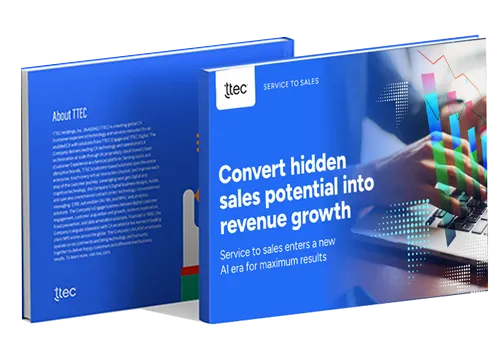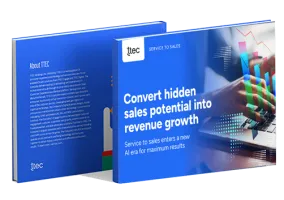Insurance is a necessity in life that customers hope they'll never need. So when the time comes for them to collect on their policy's promise, customers don't only want a seamless transaction—they also want a human interaction to help them during difficult times.
MassMutual Financial Group is a prime believer in being there for its customers during their time of need, providing life insurance, retirement, and financial products and services. "We're in the business of helping customers protect their loved ones," Vice President and Chief Customer Experience Officer Todd Lee points out. In order to deliver on this promise, MassMutual's frontline employees need to be more than well-informed about the products and services. They must be able to show empathy to a customer who has lost a spouse or is facing another life-altering situation. The organization prides itself on preparing its frontline associates to handle these sensitive situations with training and mentoring.
Lee took over the job of Chief Customer Experience Officer at the 161-year-old company earlier this year and his first order of business was to draw up a customer experience strategy, geared at ensuring that the organization understands its customer feedback. As Lee puts it, for the organization to be truly customer-centric, it needs to understand the voice of its customers, engage with customers, and follow through with them at all levels of service.
Here, Lee talks about MassMutual's efforts to be more customer-centric and the necessity for each organization to take a customer-first approach.
Customer Strategist: What are your goals as Chief Customer Experience Officer?
Todd Lee: My overall goal is to ensure that we consistently deliver an exceptional customer experience for our policy holders, our clients, producers, and employees. I'm looking at doing this in a number of different ways, the first of which is advocating on behalf of our customers and ensuring that their needs and expectations are understood by all and are at the center of what we do internally. I promote a holistic viewpoint that cuts across the organization and across boundaries to make sure that we're not constrained internally.
We've identified four core issues [that need addressing]: The changing role of advice for the consumer and how technology and the proliferation of information is beginning to change that; helping our customers manage the uncertainties throughout the years, depending upon their life stage; embracing the changing family structure, which present different needs; and demystifying the buying process to address consumers' need for transparency and simplicity in products. I'm channeling the forward-looking strategy to determine what capabilities we need to build to [address these four needs] to ensure that we're ready to exceed customer expectations.
Key to doing this is making sure that I'm proactively keeping a current perspective of the voice and pulse of our customers.
CS: Why is it imperative for your organization to provide an optimal customer experience and be customer-centric?
TL: Customer experience has always been [essential] but with today's rapidly changing marketplace, we believe it's even more important. We operate in an environment that's very competitive and it's becoming more and more difficult to [use price and product features as differentiators] since everybody's fairly close when it comes to price, and any new product feature can be duplicated fairly quickly. So, needless to say, it's our actions in customer service that are true differentiators. Connecting with, and strengthening, our ties with our customers is critical.
CS: What makes Mass Mutual customer-centric and how does the organization differ from its competitors in this regard?
TL: We strive to keep a balance in addressing the human element as we work in frontline interactions with our customers. We want to be there at [our customers'] time of need when we have to deliver our ultimate promise, which is them collecting on the benefits from the various products that we offer. Our frontline associates need to be empathic and compassionate to the needs of those who are calling because they lost a spouse and they don't know what to do. We put a lot of effort in front-line associates because it's not all about technology and programs but about that human [connection.]
One thing that really enables that is our mutuality. We exist for the benefit of our policy owners who own our company. They're our customers and have been for 161 years. We operate with that structure and this allows us to take a longer-term view and focus on the strategic investments in policies and protocols to really deliver that value.
CS: Social media is putting increased pressure on organizations to be customer-centric. How is MassMutual using social media to be more customer-focused?
TL: Social media has really [sped up the way] we connect with people and build relationships. From our perspective this is really an exciting time. One of the panel survey studies found that 78 percent of consumers under the age of 40 use social networks [to get information] when they're shopping for consumer products.
We reach out to customers on Facebook, Twitter, LinkedIn, and invite them to be part of the conversation with us. We're continuing to build our social presence with the goal of connecting and engaging with a variety of constituents, both clients and prospective clients, by using our corporate presence.
We also encourage [our network] of financial professionals to use their own pages within those respective communities to engage with their clients. This allows financial professionals to individually connect with prospects and with clients they have. We're in the process of [expanding] this program. Certainly, given the regulatory environment, there are guidelines about what they can say in those public forums. But the reality is that people are making connections through social channels and we feel we need to embrace it as we move forward.
We're working to engage brand advocates both across generations and different interest groups, interact with them with a mix of interesting, relevant, and rewarding content to help drive brand referral, rediscovery of the brand, and [for customers to] make the connection with us.
CS: What other developments are putting pressure on your organization to take a customer-first approach?
TL: Consumerization, which I would describe as technology advancement in the consumer space such as tablets coming to consumers before [they were widely accessible] to businesses, is driving innovation and rapidly changing consumer expectations and preferences. We're finding that the business space is reacting and trying to keep up with the innovation, the advancements, and changing preferences in the consumer space. For industry as a whole, that's a big challenge.
With the amount of information available online right now, consumers research companies and products more than ever, certainly before they talk to an associate and a company. Consumers are [contacting companies] knowing about the products they want to talk about and that's changing the conversation because they're more educated.
A second key trend is that technology is changing and shaping the purchase process as well as the solution space of what's being provided. Brand image is being driven by ratings and recommendations. For example, Yelp ratings have an impact on customer decisions and the way they [and other review sites] will start rating financial services and products will impact our business.
Because of the number of individuals who have smartphones, consumers expect organizations to be accessible through these devices. Technology is also enabling some non-traditional competitors to start entering the financial services space. We think that the pace of change will continue to accelerate so we need to be ready to respond to that.
CS: What are the main challenges of your job?
TL: Firstly, balancing strategic focus with tactical day-to-day activity. As we consolidate our focus on customer experience, day-to-day items pop up, from requests to review copy changes to specific wording in correspondence to outreaches to multiple vendors every week regarding their offerings to improve experience. Staying focused on the larger, strategic objectives is critical to materially improve the experience. The second challenge is maintaining a holistic, end-to-end view of the experience across the organization. While departments are executing programs and projects to improve within their specific function, ensuring that they take the time and keep an end-to-end view is key.
CS: How do you make sure that the C-Suite's customer-centric goals are properly transferred to employees throughout the organization?
TL: That goes back to our mutuality—it's in our mission. The CEO and senior leadership hold associate meetings and [customer-centricity] is always a part of the communication where we talk about the value we provide. We're very consistent in top-down messaging and have it built into our formal annual review process. We have a section called the Winning Ways and this includes five elements, one of which is to focus on customers. We specifically provide feedback to our associates twice a year relative to this aspect.
My team is also talking to the entire organization about our customer-centric strategy to promote how we need to continue to enhance our capabilities to exceed customer expectations.
















